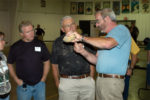Advertise Follow Us
Articles Tagged with ''navicular bone''
The newborn foal had no coffin bone, no navicular bone and incomplete development of the short pastern bone
Read More
Heard at the Summit
Shoeing Around the Coffin Joint
Scottish farrier Jim Ferrie says to let the coffin joint guide you when tackling cases of imbalance
Read More
Advice for Dealing with Underrun Heels in Western Peformance Horses
A pair of Texas farriers share how they deal with this all-too-common problem
Read More
Breeding Better Feet
When it comes to foot conformation, there are more questions than answers
Read More
Navicular or Not?
Farrier argues that many “navicular” lameness are actually caused by something else — that requires a different trimming and shoeing approach
Read More
Advising Horse Owners on How to Head Off Navicular Disease
Veterinarian Dallas O. Goble believes understanding the basics of navicular disease will allow you to better serve your clients
Read More
An Equine Foot Form and Function Review
Hall Of Fame equine vet stresses importance of anatomical relationships during clinic
Read More
Hoof Care and the Coffin Bone
Understanding the form and function of the distal phalanx is vital to keeping horses sound
Read More
Navicular or Balance-Related Navicular Syndrome
Suspected and unproven navicular disease concerns should sound a warning bell
Read More









